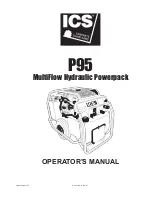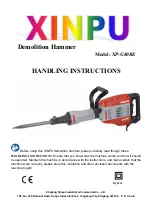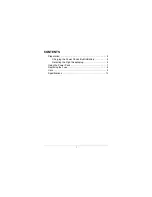
12
6.7
Electrical Connections
Electrical connections must
be made by a qualified electrician in
compliance with all relevant codes.
The powerfeeder is equipped with a 110 volt motor
and a plug designed for use on a circuit with a
grounded outlet
that looks like the one pictured in
A
, Figure 11.
6.7.1
Grounding instructions
1. All Grounded, Cord-connected Tools:
In the event of a malfunction or breakdown,
grounding provides a path of least resistance for
electric current to reduce the risk of electric shock.
This tool is equipped with an electric cord having
an equipment-grounding conductor and a
grounding plug. The plug must be plugged into a
matching outlet that is properly installed and
grounded in accordance with all local codes and
ordinances.
Do not modify the plug provided - if it will not fit the
outlet, have the proper outlet installed by a
qualified electrician.
Improper connection of the equipment-grounding
conductor can result in a risk of electric shock. The
conductor with insulation having an outer surface
that is green with or without yellow stripes is the
equipment-grounding conductor. If repair or
replacement of the electric cord or plug is
necessary, do not connect the equipment-
grounding conductor to a live terminal.
Check with a qualified
electrician or service pe
r
sonnel if the
grounding instructions are not completely
understood, or if in doubt as to whether the
tool is properly grounded. Failure to comply
may cause serious or fatal injury.
Use only 3-wire extension cords that have 3-prong
grounding plugs and 3-pole receptacles that accept
the tool's plug.
Repair or replace damaged or worn cord
immediately.
2. Grounded, cord-connected tools intended for
use on a supply circuit having a nominal rating less
than 150 volts:
This tool is intended for use on a circuit that has an
outlet that looks like the one illustrated in
A,
Figure
11. An adapter, shown in
B
and
C
, may be used to
connect this plug to a 2-pole receptacle as shown
in
C
if a properly grounded outlet is not available.
The temporary adapter should be used only until a
properly grounded outlet can be installed by a
qualified electrician.
This adapter is not permitted
in Canada.
The green-colored rigid ear, lug, and
the like, extending from the adapter must be
connected to a permanent ground such as a
properly grounded outlet box.
Figure 11
6.7.2
Extension Cords
The use of extension cords is discouraged; try to
position equipment within reach of the power
source. If an extension cord becomes necessary,
make sure the cord rating is suitable for the
amperage listed on the machine’s motor plate. An
undersized cord will cause a drop in line voltage
resulting in loss of power and overheating.
Use Table 1 as a general guide in choosing the
correct size cord. If in doubt, use the next heavier
gauge. The smaller the gauge number, the heavier
the cord.
Recommended Gauges (AWG) of Extension Cords
Amps
Extension Cord Length *
25
feet
50
feet
75
feet
100
feet
150
feet
200
feet
< 5
16
16
16 14 12
12
5 to 8
16
16
14 12 10
NR
8 to 12
14
14
12 10 NR
NR
12 to 15
12
12
10 10 NR
NR
15 to 20
10
10
10
NR
NR
NR
21 to 30
10
NR
NR
NR
NR
NR
*based on limiting the line voltage drop to 5V at 150%
of the rated amperes.
NR: Not Recommended.
Table 1
Содержание TPFA-X
Страница 8: ...8 6 3 X Axis installation and features Figure 5...
Страница 14: ...14 8 1 1 Table Powerfeed Exploded View...
Страница 16: ...16 9 0 Electrical Connections...


































